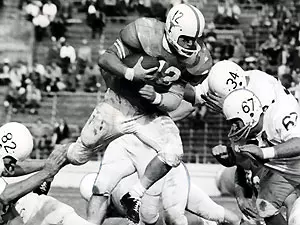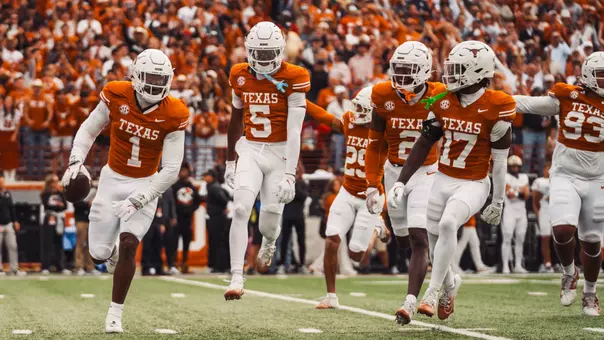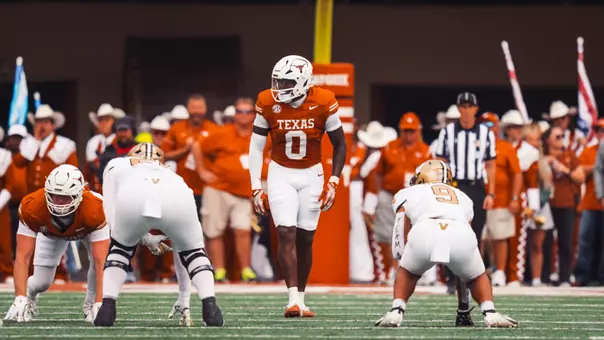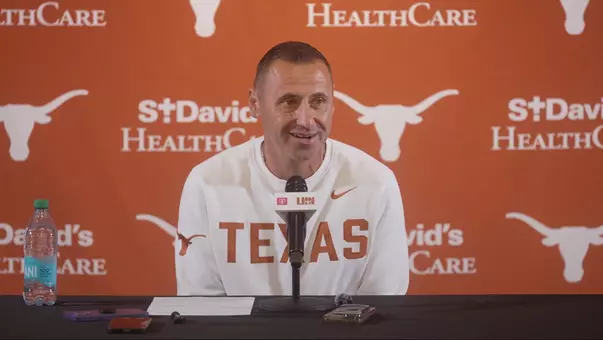The University of Texas at Austin Athletics

Bill Little commentary: A reason to remember
11.03.2006 | Football
In 1995, when the Longhorns played at Hawaii, the world was observing the 50th anniversary of the end of World War II. There was immense irony in the contrast of the visitors to the islands.
On the one hand, you had President Clinton and the World War II veterans who were returning to the place where the United States' involvement in the war had started. Wreathes were laid on the sea above the Battleship Arizona, the most visible symbol of the Japanese attack on Pearl Harbor in 1941.
At the same time, you had a Texas football team, with an average age somewhere around 19, there to play a game. When they held their workouts in preparation for the contest, they practiced just below the famous "Punch Bowl Cemetery," a national memorial actually built into the crater of a volcano.
The name comes, not from a celebration, but from the Hawaiian word "Puowaina," which means "hill of sacrifice." More than 38,000 men and women, veterans of World War II, Korea and Vietnam, are buried there.
One of the highlights of the events during that trip was an ocean parade of an armada of the ships of the Allied Nations who fought in that war. A reporter for the Honolulu newspaper covering the story as the old veterans tossed the flowers into the sea wondered about the scene.
As he observed the aging men who stood aboard the ship, some still fitting into their old uniforms and saluting through hands crooked with time, he wondered, "When they are all gone, who will remember?"
Saturday, in ceremonies in Darrell K Royal-Texas Memorial Stadium, we recognize those who are making sure that somebody will.
Each year, one football game is designated for Veterans Recognition Day. When the original stadium was built in 1924, it was dedicated as Texas Memorial Stadium to those who had served from The University and The State in World War I. It was called "The Great War," then. "The War to End All Wars."
A noble thought, perhaps a dream, but what history tells is, that didn't happen.
As the years have passed, the stadium has been rededicated to all of the veterans who have served in all foreign conflicts in which America has been involved.
A Veterans Committee, headed by World War II veteran Frank Denius, has been established to make sure the original goal of remembering those who served our country is always maintained.
This summer, the committee oversaw the "decommissioning" of the original plaque at the north end of the stadium, which contained the names of all of those Texans who died in World War I. Immediately after this season, the North End of the stadium will be demolished to make way for a new end zone project. Included in that will be a Memorial Park recognizing the veterans, and the original plaque will be relocated there.
Denius, one of the ten-most decorated soldiers in the European Theater of World War II, is joined on the committee by a group of veterans that includes men who have served in almost every foreign conflict.
The members include former UT President William Livingston, former UT quarterback Mike Cotten, who served as a Marine in Vietnam, and Lt. Col. David Little, USMC Reserve, who served in Iraq. Others are Ernest C. Banasau Jr., James Broaddus, Thomas Hatfield, Ralph Langley, Lawson Magruder, Hilmar Moore, and Howard Terry.
Longhorn football players are regularly reminded of the importance, and the relationship, of the history of the stadium to today. Most recently, Ahmard Hall, a Longhorn captain last season, brought awareness because of his veteran's status as a Marine who served in Kosovo and Afghanistan.
The Longhorn special teams are named "The Special Forces" in honor of Denius, who was part of the "D-Day" Allied invasion of France on June 6, 1944.
With each Veterans Recognition game, The University recognizes service personnel who are putting themselves in harm's way every day. A year ago, when committee member David Little returned from serving in the Al Anbar province in Western Iraq, a bystander was talking with him after the fly-over of jets at the end of the National Anthem. Noticing the deafening sound, the man asked him, "David, how often did you hear that sound over there?"
"Every day," came the reflective, solemn reply.
Recently, a movie has been made from the popular historical book "Flags of Our Fathers." It is an account of the battle of Iwo Jima. Former Longhorn center Keifer Marshall isn't depicted in the movie, but he could be. He played every play for the Longhorns in the Cotton Bowl game in 1943, and was one of the survivors of the Battle of Iwo Jima.
In the tunnel in the North End of the stadium, there is a plaque honoring those Longhorn football players who died in World War I. The flagpole memorial in the southeast corner of the stadium is a replica of one originally given by the people of Fredericksburg, Texas, in honor of favorite son, Louis Jordan. Jordan was a UT team captain who was one of the first UT students to die in France in World War I.
Perhaps the strongest answer to the question of "Who will tell their story?" comes from fathers to sons, and there is no stronger tie or better example of that than UT co-defensive coordinator Gene Chizik.
Chizik grew up with a father who was his best friend, a long-time school administrator who was a Marine in World War II. He knew that his father had won a medal, in fact he had played with it when he was a kid.
But he didn't learn the story he will now tell to his children until his Dad was dying. When Gene Chizik, Sr., was in the twilight of his life, in the final days, an old friend came to visit him in the hospital.
"That's okay, Chizik," said his friend. "You had 53 years more than you should have."
When the conversation finished and the man walked into the hall, Gene Chizik, Jr., asked him what he meant.
"Didn't he ever tell you about Sugar Loaf Hill?" he asked. "That's where he got his Bronze Star. A hundred and forty of them went up, and 12 came back. He was one of the front liners."
In his book, Goodbye Darkness, famed author William Manchester talks about his own time on Sugar Loaf Hill, where it took 10 days and cost 7,547 Marine casualties to win the last great battle of World War II, one which Newsweek Magazine called "the most critical local battle of the war." It has over been 60 years since William Manchester and Gene Chizik, Sr., fought there.
Several years ago, working through a sea of memories that had troubled him most of his life, Manchester visited Sugar Loaf Hill years after the battle, and found some answers.
"Men," he wrote, "I now knew, do not fight for flag or country, for the Marine Corps or glory or any other abstraction. They fight for one another."
But what Gene Chizik will be able to tell his children is, they fought for us.
When David Little returned from Iraq, he sent an e-mail that gave another reason:
"I cannot leave this place," he wrote, "without remembering those who will not return. Both friends and Marines and sailors I did not know shed their blood and gave their lives here. They believed in what they were doing. They took a stand and made a difference with their lives, and are to be respected for that. They stepped up and faced death so that others would not have to, and they are to be honored for that.
"And, they gave of themselves selflessly so that my children and yours can play in the yard, go to school, and live their lives without fear...they are to be thanked for that."
And tonight, that is what we remember.





